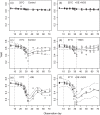Does trophic status enhance or reduce the thermal tolerance of scleractinian corals? A review, experiment and conceptual framework
- PMID: 23349876
- PMCID: PMC3547885
- DOI: 10.1371/journal.pone.0054399
Does trophic status enhance or reduce the thermal tolerance of scleractinian corals? A review, experiment and conceptual framework
Abstract
Global warming, and nutrient and sediment runoff from coastal development, both exert increasing pressures on coastal coral reefs. The objective of this study was to resolve the question of whether coastal eutrophication may protect corals from thermal stress by improving their nutritional status, or rather diminish their thermal tolerance through the synergy of dual stressors. A review of previous studies on the topic of combined trophic status and heat exposure on the thermal tolerance of corals reveals a broad range of outcomes, including synergistic, additive and antagonistic effects. We conducted a 90-day long experiment exposing corals to realistic levels of elevated nutrients and sediments, and heat stress. Colonies of two common scleractinian corals (Acropora millepora and Montipora tuberculosa) were kept in coastal seawater, or coastal seawater that was further organically and nutrient enriched (OE), and/or enriched with nitrate. Batches of OE were created daily, facilitating nutrient uptake, plankton succession and organic enrichment as observed in coastal waters. After 10 days of acclimation, 67% of the colonies had their temperature gradually increased from 27° to 31.2°C. After 3-7 weeks of heat stress, colonies of both species had significantly greater reductions in fluorescence yields and lower survival in OE than without addition of OE. Furthermore, photophysiological recovery was incomplete 31-38 days after ending the heat stress only in the OE treatments. Nitrate alone had no measurable effect on survival, bleaching and recovery in either species. Skeletal growth rates were reduced by 45% in heat-stressed A. millepora and by 24% in OE-exposed M. tuberculosa. We propose a conceptual trophic framework that resolves some of the apparently contradictory outcomes revealed by the review. Our study shows that management actions to reduce coastal eutrophication can improve the resistance and resilience of vulnerable coastal coral reefs to warming temperatures.
Conflict of interest statement
Figures





References
-
- Hoegh-Guldberg O, Mumby PJ, Hooten AJ, Steneck RS, Greenfield P, et al. (2007) Coral reefs under rapid climate change and ocean acidification. Science 318: 1737–1742. - PubMed
-
- De’ath G, Lough JM, Fabricius KE (2009) Declining coral calcification on the Great Barrier Reef. Science 323: 116–119. - PubMed
-
- Fuessel HM (2009) An updated assessment of the risks from climate change based on research published since the IPCC Fourth Assessment Report. Climatic Change 97: 469–482.
-
- Lough J (2011) Great Barrier Reef coral luminescence reveals rainfall variability over northeastern Australia since the 17th century. Paleoceanography 26: PA2201 doi:2210.1029/2010PA002050.
-
- McCulloch M, Fallon S, Wyndham T, Hendy E, Lough J, et al. (2003) Coral record of increased sediment flux to the inner Great Barrier Reef since European settlement. Nature 421: 727–730. - PubMed
Publication types
MeSH terms
LinkOut - more resources
Full Text Sources
Other Literature Sources

